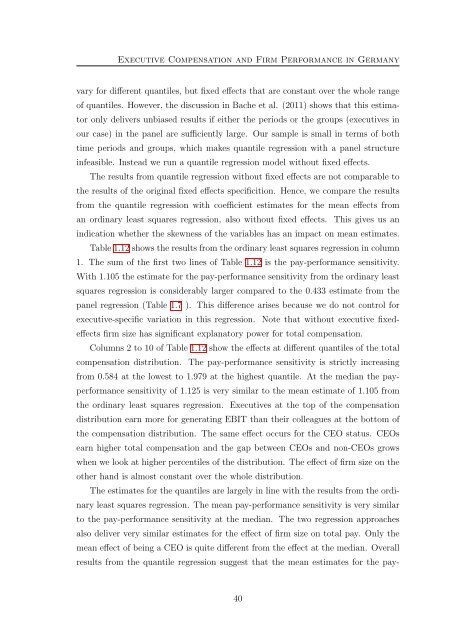Three Essays on Executive Compensation - KOPS - Universität ...
Three Essays on Executive Compensation - KOPS - Universität ...
Three Essays on Executive Compensation - KOPS - Universität ...
You also want an ePaper? Increase the reach of your titles
YUMPU automatically turns print PDFs into web optimized ePapers that Google loves.
<strong>Executive</strong> Compensati<strong>on</strong> and Firm Performance in Germany<br />
vary for different quantiles, but fixed effects that are c<strong>on</strong>stant over the whole range<br />
of quantiles. However, the discussi<strong>on</strong> in Bache et al. (2011) shows that this estimator<br />
<strong>on</strong>ly delivers unbiased results if either the periods or the groups (executives in<br />
our case) in the panel are sufficiently large. Our sample is small in terms of both<br />
time periods and groups, which makes quantile regressi<strong>on</strong> with a panel structure<br />
infeasible. Instead we run a quantile regressi<strong>on</strong> model without fixed effects.<br />
The results from quantile regressi<strong>on</strong> without fixed effects are not comparable to<br />
the results of the original fixed effects specificiti<strong>on</strong>. Hence, we compare the results<br />
from the quantile regressi<strong>on</strong> with coefficient estimates for the mean effects from<br />
an ordinary least squares regressi<strong>on</strong>, also without fixed effects. This gives us an<br />
indicati<strong>on</strong> whether the skewness of the variables has an impact <strong>on</strong> mean estimates.<br />
Table 1.12 shows the results from the ordinary least squares regressi<strong>on</strong> in column<br />
1. The sum of the first two lines of Table 1.12 is the pay-performance sensitivity.<br />
With 1.105 the estimate for the pay-performance sensitivity from the ordinary least<br />
squares regressi<strong>on</strong> is c<strong>on</strong>siderably larger compared to the 0.433 estimate from the<br />
panel regressi<strong>on</strong> (Table 1.7 ). This difference arises because we do not c<strong>on</strong>trol for<br />
executive-specific variati<strong>on</strong> in this regressi<strong>on</strong>. Note that without executive fixedeffects<br />
firm size has significant explanatory power for total compensati<strong>on</strong>.<br />
Columns 2 to 10 of Table 1.12 show the effects at different quantiles of the total<br />
compensati<strong>on</strong> distributi<strong>on</strong>. The pay-performance sensitivity is strictly increasing<br />
from 0.584 at the lowest to 1.979 at the highest quantile. At the median the payperformance<br />
sensitivity of 1.125 is very similar to the mean estimate of 1.105 from<br />
the ordinary least squares regressi<strong>on</strong>. <strong>Executive</strong>s at the top of the compensati<strong>on</strong><br />
distributi<strong>on</strong> earn more for generating EBIT than their colleagues at the bottom of<br />
the compensati<strong>on</strong> distributi<strong>on</strong>. The same effect occurs for the CEO status. CEOs<br />
earn higher total compensati<strong>on</strong> and the gap between CEOs and n<strong>on</strong>-CEOs grows<br />
when we look at higher percentiles of the distributi<strong>on</strong>. The effect of firm size <strong>on</strong> the<br />
other hand is almost c<strong>on</strong>stant over the whole distributi<strong>on</strong>.<br />
The estimates for the quantiles are largely in line with the results from the ordinary<br />
least squares regressi<strong>on</strong>. The mean pay-performance sensitivity is very similar<br />
to the pay-performance sensitivity at the median. The two regressi<strong>on</strong> approaches<br />
also deliver very similar estimates for the effect of firm size <strong>on</strong> total pay. Only the<br />
mean effect of being a CEO is quite different from the effect at the median. Overall<br />
results from the quantile regressi<strong>on</strong> suggest that the mean estimates for the pay-<br />
40
















